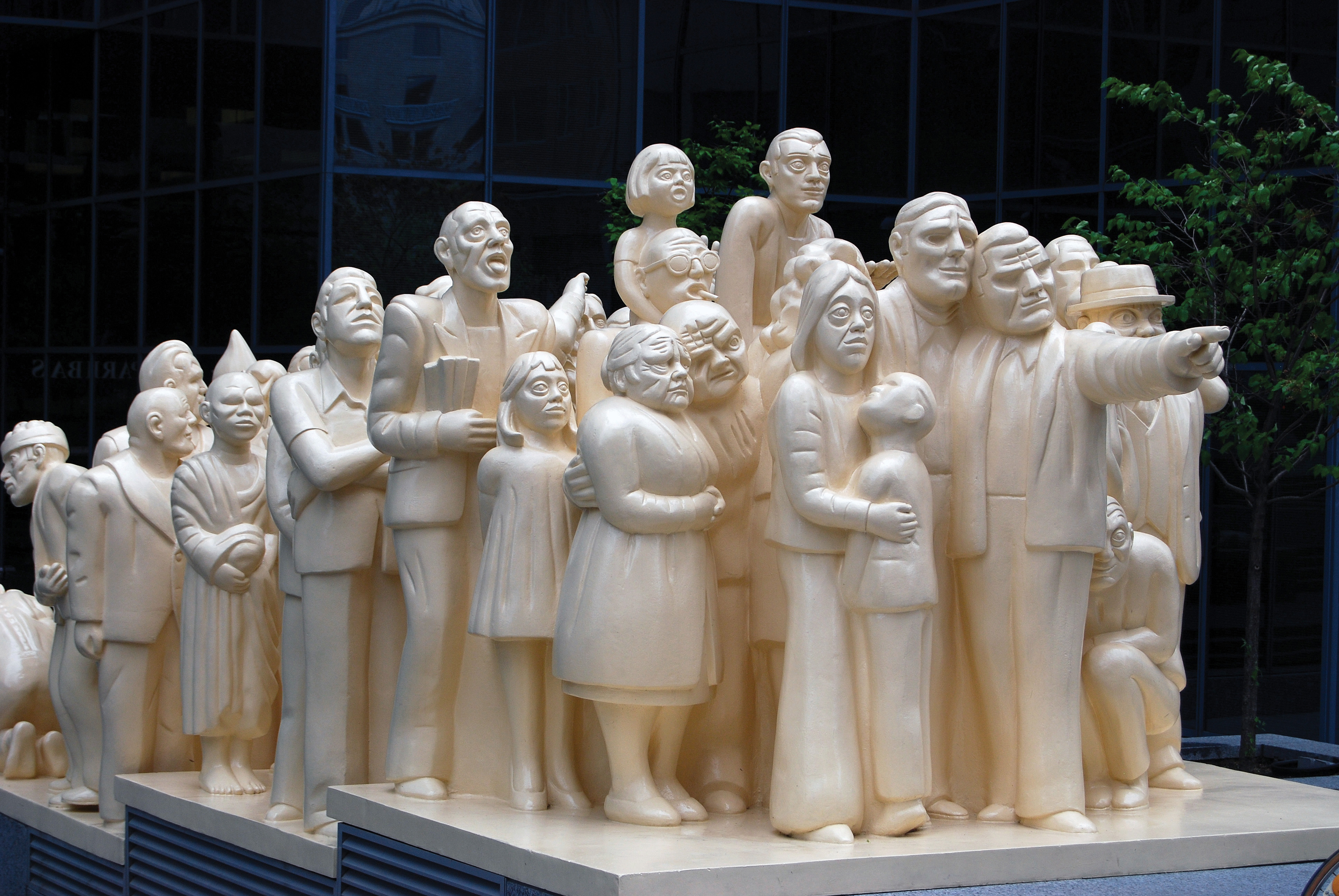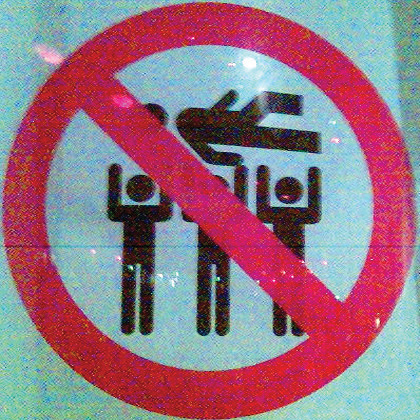This is “Case Studies”, section 10.6 from the book Business Ethics (v. 1.0). For details on it (including licensing), click here.
For more information on the source of this book, or why it is available for free, please see the project's home page. You can browse or download additional books there. To download a .zip file containing this book to use offline, simply click here.
10.6 Case Studies
The Zinger and the Slur

Source: Photo courtesy of David Goehring, http://www.flickr.com/photos/carbonnyc/99785459/.
Football coach Joe Paterno’s on-field prowess is only slightly more legendary than his sharp tongue. This is one crowd favorite: “If I ever need a brain transplant, I want one from a sports writer because I’ll know it’s never been used.”Mike Bianchi, “Panthers Gm Proves Paterno Barb Wrong,” Orlando Sentinel, January 31, 2004, accessed May 31, 2011, http://articles.orlandosentinel.com/2004-01-31/sports/0401310276_1_sports-writer-silly-stuff-recruiting-visits.
Most people find this to be pretty funny. And though it rubs some sports writers the wrong way, no one is going to file a lawsuit or claim antidiscriminatory protection is needed to protect the offended. On the other hand, JoePa—as he’s called around Pennsylvania—himself suffered taunting as a younger man. People called him a “wop,” a slur attacking someone’s Italian heritage (like the more common “guido” or calling a Chinese person a “Chink”).
Question
- From an ethical viewpoint, and within a discussion of discrimination, why does the brain transplant zinger get a green light while the wop slur seems objectionable?
Working at Columbia University

Source: Photo courtesy of Tim Schapker, http://www.flickr.com/photos/albany_tim/3536902765.
This comes from the Columbia University website: “As an equal opportunity and affirmative action employer, the University does not discriminate against or permit harassment of employees or applicants for employment on the basis of race, color, sex, gender (including gender identity and expression), pregnancy, religion, creed, national origin, age, alienage and citizenship, status as a perceived or actual victim of domestic violence, disability, marital status, sexual orientation, military status, partnership status, genetic predisposition or carrier status, arrest record, or any other legally protected status.”“Office of Equal Opportunity and Affirmative Action,” Columbia University, accessed May 31, 2011, http://www.columbia.edu/cu/vpaa/eoaa.
Questions
- Looking at this list of characteristics that Columbia doesn’t discriminate against, can you quickly put in your own words what each of them means?
-
What’s the difference between unintentional and intentional discrimination?
- Are some of these characteristics more vulnerable than others to unintentional discrimination? Which ones? Why?
- Are some of these characteristics more vulnerable than others to intentional discrimination? Which ones? Why?
- Which of the protected characteristics are concealable, meaning that in most cases a job applicant could fairly easily hide or not reveal whether he or she has the trait? Which aren’t so concealable?
- Which characteristics are universal (we’re all afflicted and therefore vulnerable to discrimination) and which ones are individual (some of us have the trait and some don’t)? In your opinion is one group more vulnerable to discrimination? Why?
- If you wanted to stop discrimination at Columbia University, could you rank the protected characteristics in terms of their importance? Which forms of discrimination would be most important to combat and which wouldn’t matter so much? Or are they all equally important? Justify your answer.
- Are there any characteristics you would add to the list? In terms of doing ethics, is there any problem with a list this long?
- Are there any characteristics that really shouldn’t be on the list? Which ones? Why?
-
Hypothetically, John Smith has applied for a maintenance post at Columbia. The job entails routine and emergency plumbing and fixing of general problems, everything from burned-out lightbulbs to graffiti. More or less, the job is to walk around and make sure things are in working order. He’d be working the night shift from 11 p.m. to 7 a.m. His assigned buildings would be a classroom and three coed dorms. He has been arrested three times for attempted rape of young women, but there was never enough evidence to convict.
- Susan Rieger heads the Columbia University employment office. It’s part of her job to defend the school’s policies. In ethical terms, how do you suppose she might defend Columbia’s refusal to discriminate on the basis of arrest record?
-
Columbia won’t discriminate on the basis of religious belief. Historically, some creeds have been singled out more than others for abuse, but one that’s not often found on the list of mistreatment is Haitian Voodoo. Houngan Hector of New Jersey identifies himself as an asogwe priest of Haitian voodoo. His story is interesting. He claims to have been “mounted” by an ancestor at the age of seven, and so began his spiritual journey. Eventually, it led Houngan Hector to perform spiritual cleansings for money. They haven’t always gone well. According to this newspaper story in the Philadelphia Daily News: “Lucille Hamilton paid $621 to have her ‘spiritual grime’ removed by voodoo high priest Houngan Hector in an ordinary townhouse in Camden County. Hamilton, 21, a male living as a woman, flew in on Friday from her home in Little Rock, Arkansas to take part in the three-day spiritual cleansing. By Saturday night Hamilton was dead, and authorities are awaiting results of an autopsy and toxicology tests to determine exactly what happened.”“Transvestite Dies At Voodoo Ceremony,” OddCulture, accessed May 31, 2011, http://oddculture.com/culture/transvestite-dies-at-voodoo-ceremony.
Here’s Houngan Hector’s advertisement for his services on his MySpace page, as it was reported in OddCulture: “I have over 15 years of experience helping individuals resolve their issues, and well over 9 years of helping people through the means of the Haitian Voodoo tradition. Having gotten individuals out of jail, brought lovers back, and improved people’s financial situation, I keep myself humble remembering it is not I who does it. It is God and Ginen who resolves.”“Transvestite Dies At Voodoo Ceremony,” OddCulture, accessed May 31, 2011, http://oddculture.com/culture/transvestite-dies-at-voodoo-ceremony.
The three basic ethical arguments against discrimination (and, in this case, discrimination based on personal religious belief) are fairness, rights, and utilitarianism.
- Choose one and make the case that Houngan Hector—who was never charged with any crime—should be treated like any other applicant for a job at Columbia University.
- Can any of the three arguments be used to show that discriminating against Haitian voodoo believers is ethically acceptable, even recommendable?
Susan Rieger in Trouble: Randy Raghavendra and Zenobia White-Farrell

Source: Photo courtesy of Richard Rutter, http://www.flickr.com/photos/clagnut/46815739.
Susan Rieger heads Columbia University’s Office of Equal Opportunity and Affirmative Action, and she has a tough case with Randy Raghavendra. He’s an analyst at Columbia’s Office of Institutional Real Estate who got passed over for a promotion. The spot went to a younger white woman. Raghavendra, who’s a dark-skinned Indian American, accused that “Columbia practices blatant racial discrimination and various deceptive tactics to keep out blacks and other dark-skinned minorities from higher-paying managerial and executive positions of power.”“NRI Sues Columbia University for Racism, Times of India, November 22, 2003, accessed May 31, 2011, http://businessethicsworkshop.com/Chapter_10/susan_rieger_in_trouble.html.
Questions
The case’s specifics go back and forth:
-
Raghavendra points out that when he interviewed for the promotion, it had already been given to the white woman. His interview, therefore, was a “joke,” as he put it, “a fake interview.” The university answered that the hiring for that post had been handled by an outside headhunting company, which was a common practice at Columbia.
Assume the outside company did engage in discriminatory practices. Does the fact that it’s an independent enterprise cleanse Columbia University of responsibility? Or is the university equally responsible? Or is it actually worse that they’re hiding behind an outside firm? Justify your answer.
-
An administrator at the university once asked Raghavendra, “Do you often get hassled at airport security?” The suggestion, according to Raghavendra, was that he looked like a potential terrorist. The administrator didn’t deny the comment but affirmed that the idea that it was racist was “bizarre” and “silly beyond belief.”
- How could you make the case that this is an example, of individual, isolated, unintentional discrimination?
- Who gets to decide whether a comment is racist? How is the decision made? Does or doesn’t this conflict resemble the one you see on MTV videos where blacks openly refer to each other with a specific term that would earn a white person who used the word a lifetime ban from the channel?
-
Raghavendra argues that he didn’t get his own office while several white workers in lower posts did have their own office as well as a separate mailbox. The university responded that office and mailbox space is distributed by seniority: the lower-level white workers who had their own office had worked there longer.
Seniority is viewed by most as a generally fair way of distributing offices. It’s also fair, according to common opinion, to divide them up in terms of rank. Would it be right or wrong, however, for Columbia to simply say that either of the two systems will be used interchangeably, but the choice will be made in terms of minorities: whichever system allots the best offices to minorities will be implemented? Justify your answer.
-
Raghavendra originally took his case to Susan Rieger, head of the Office of Equal Opportunity and Affirmative Action. After three months he withdrew it, however, claiming that they played games with him and never really investigated the charges. The university responded that he “failed to utilize internal administrative remedies provided by Columbia.”
Raghavendra is claiming that Columbia discriminates against him. As an employee of Columbia, does he have any ethical responsibility to try to work out the issue inside that organization? If so, what is the responsibility? As a member of society, does he have an obligation to take his claim outside the university? If so, what is the responsibility?
- Raghavendra sued for punitive damages. That’s money as punishment for discrimination, and it’s an amount beyond that which may have been lost in wages and benefits because of mistreatment. More, as part of any settlement, Raghavendra wanted to be awarded a job assignment as manager of finance and accounting at Columbia. He says he’d like to stay at the university after the suit is settled. Does this decision affect the way you see his case against Columbia? Why or why not? Should it? Why or why not?
-
Raghavendra notes that there are no African Americans in higher-level positions in his office. There is a Pakistani who has a higher title, but Raghavendra points out “he’s not really that dark-skinned.”
Within the context of the ethics of discrimination, what does it mean to be a victim? What types of victimhood are there? Is there any reason to ask here whether Raghavendra might be one of these kinds of victims? If so, what is it? If not, why not?
-
What makes the case especially difficult for Rieger, the Columbia point person on all this, is that she’s trying to balance discrimination claims while fending off a lawsuit herself. Her post had been occupied—on a provisional basis—by Zenobia White-Farrell, a black woman. Columbia offered to make the job permanent with a salary of $80,000. White-Farrell responded that she’d accept but only on the condition that the salary was upped to $100,000. Columbia offered only $83,000. White-Farrell resigned. Soon after, Columbia hired Rieger at a salary of $107,000. White-Farrell sued, alleging discrimination.
- What factors could possibly have justified offering Rieger so much more than White-Farrell?
- How could you describe this case as an example of a glass ceiling for minority women?
- The Columbia nondiscrimination code protects both gender minorities (women) and racial minorities. Is White-Farrell more protected than Rieger because she fits two categories and Rieger only one? Does the answer affect the ethical strength of White-Farrell’s case? Justify your answer.
- Assume that, strictly in terms of merit, Rieger deserved a higher salary than White-Farrell for the same job. Rieger had, say, more years of experience and a higher degree. Could you make a utilitarian argument that because the ethically right thing to do is just that which serves the general society’s welfare, White-Farrell should have been offered $100,000, even though, again, strictly in terms of merit, she didn’t deserve that much?
-
Columbia University is an Affirmative Action institution. They aren’t satisfied with gender and racial neutrality; it’s the institution’s policy to promote and to some extent favor minority candidates for jobs.
- Can you make the case that, with respect to the particular job of overseeing all hiring at the university, there’s a good practical reason—which is also ethically acceptable—to seek a white male to direct the office? What is the case?
- Can you make the case that with respect to this particular job, there’s a good practical reason—which is also ethically acceptable—to seek a multiple minority (a gender plus racial minority or some similar combination) to direct and oversee hiring? What is the case?
- The name of the office Susan Rieger leads is the Office of Equal Opportunity and Affirmative Action. What is “Equal Opportunity?” What is “Affirmative Action?” Does the title of this office make sense? If so, how? If not, why not?
Google Celebrates Diversity…and Profit

Source: Photo courtesy of dichohecho, http://www.flickr.com/photos/dichohecho/2545363497.
This statement comes from Google CEO Eric Schmidt on the corporate web page titled “Google Celebrates Diversity”: “Our products and tools serve an audience that is globally and culturally diverse—so it’s a strategic advantage that our teams not only encompass the world’s best talent but also reflect the rich diversity of our customers, users, and publishers. It is imperative that we hire people with disparate perspectives and ideas, and from a broad range of cultures and backgrounds. This philosophy won’t just ensure our access to the most gifted employees; it will also lead to better products and create more engaged and interesting teams.”“Diversity@Google: A place to be you,” Google, accessed May 31, 2011, http://www.google.com/corporate/diversity/index.html.
This is a very carefully worded paragraph, and beneath its motivational tone there are firm statements about diversity in the Google workplace. They include the following:
- Google carefully avoids mentioning race, gender, and similar requirements for any particular position. The company doesn’t get involved in discussions about how many Catholic females over fifty years old and with a disability work there. Like most contemporary organizations, Google avoids strict quota systems.
- Google will seek to hire “the world’s best talent.”
- Google, apart from hiring the best raw talent, will seek employees reflecting “the rich diversity of our customers.”
There are also clear justifications for the diversity side of the hiring strategy. Google will take action to contract a rainbow of workers because
- diversity in hiring will help Google connect with its diverse consumer base,
- diversity in hiring will ensure Google has access to all gifted employees,
- diversity in hiring will help Google produce better products,
- diversity in hiring will help Google create more engaged and interesting teams.
Concretely, what is Google doing to diversify the people forming its company? Besides directly hiring a diverse workforce, the company offers a number of scholarships and internships aimed at those historically underrepresented in the technology industry.“Diversity and students,” Google, accessed May 31, 2011, http://www.google.com/diversity/students.html.
Questions
-
In a nutshell, the commonly cited arguments in favor of affirmative action include the following:
- It creates fairness and equal opportunity within organizations.
- It benefits third parties: society as a whole will be more harmonious as discrimination recedes.
- It reduces tensions in an organization.
- It benefits organizations by helping them reach their goals.
- It is compensation for past wrongs.
Which of these arguments appear to stand behind affirmative action at Google? Explain. Are any of the other justifications applicable even though they may not be the reason Google seeks diverse talent?
- In sweeping terms there are two types of arguments in favor of affirmative action. First, it serves a broad social good by integrating society. Second, companies employing affirmative action do better in the marketplace than those that don’t. If you had to choose one of these as a better and more persuasive argument for affirmative action, which would you choose? Why?
- At some publicly funded universities, scholarships are, in essence, set aside for minorities. Google privately funds scholarships that are, in essence, set aside for minorities. Taxpayers, in other words, fund one affirmative action endeavor and private investors the other. Now, is one endeavor ethically superior to the other? Why or why not?
-
In a nutshell, the basic arguments against affirmative action include the following:
- It is essentially discrimination, and therefore it reinforces what it combats.
- The best way to eliminate discrimination is to let equal opportunity law, markets, and time do their work.
- It is unfair to minorities who are treated as tokens.
- Forcing organizations to evaluate talent in ways outside of merit diminishes their competitiveness.
- It creates resentment and tensions in an organization.
- It doesn’t compensate past wrongs (because those benefitting and suffering today aren’t those who suffered and benefitted in the past).
Looking at this list, how do you suppose Google CEO Eric Schmidt might argue against each item?
- With an eye on these arguments against affirmative action, can you make the case that Google’s efforts are ethically reproachable?
- What does the veil of ignorance test for discrimination? Put yourself under the veil of ignorance. Now, do you believe Google’s hiring policies are ethically good or bad? Why?
Susan Rieger in More Trouble: Madonna Constantine

Source: Photo courtesy of BY-YOUR-⌘, http://www.flickr.com/photos/aparejador/2482604806.
Madonna Constantine is a professor of psychology and education specializing in race studies and prejudice. Growing up as one of five children in a lower-middle-class family in Lafayette, Louisiana, she’d benefitted from parents who never finished college and vowed she would: they saved and scrimped together enough money to get her started at the upper level. Constantine took it from there. She began her remarkable journey at Xavier in New Orleans. Next, she went to the University of Memphis, and then to the University of Texas, and Temple University, and finally to the Ivy League’s prestigious Columbia, where she earned tenure with more than thirty articles authored and published: “Most people may go up for tenure with 15 or 20 articles,” she said. “I figured as a black woman, I needed at least double that.”Elissa Gootman, “Noose Case Puts Focus on a Scholar of Race,” New York Times, October 12, 2007, accessed May 31, 2011, http://www.nytimes.com/2007/10/12/education/12columbia.html?_r=1&pagewanted=all.
As it turned out, the numbers weren’t the whole truth. Constantine had plagiarized significant amounts of her writings from students and another professor. Upon discovering the truth, Columbia fired her. Constantine responded, “I am left to wonder whether a white faculty member would have been treated in such a publicly disrespectful and disparaging manner.”Karen W. Arenson and Elissa Gootman, “Columbia Cites Plagiarism by a Professor,” New York Times, February 21, 2008, accessed May 31, 2011, http://www.nytimes.com/2008/02/21/education/21prof.html.
Next, she sued Columbia for racial discrimination.
Columbia University is having a rough time: Randy Raghavendra, Zenobia White-Farrell, and Madonna Constantine are all suing the traditionally very white institution for color discrimination.
Questions
- In your own words, and in general terms since there isn’t space here to provide every detail of every case, what would it mean to accuse these people of being victims? What’s the difference between strong and weak victimhood?
- With the facts provided, create a picture of Madonna Constantine as a victim. What kind of victim would she be? How could that conclusion be supported?
- Sketch an argument that society as a whole is better off with occasional cases of discrimination than it is with occasional cases of victimhood.
- Use a utilitarian argument to make the case that even if Columbia’s affirmative action policies are fostering cases of victimization, they should maintain those policies.




